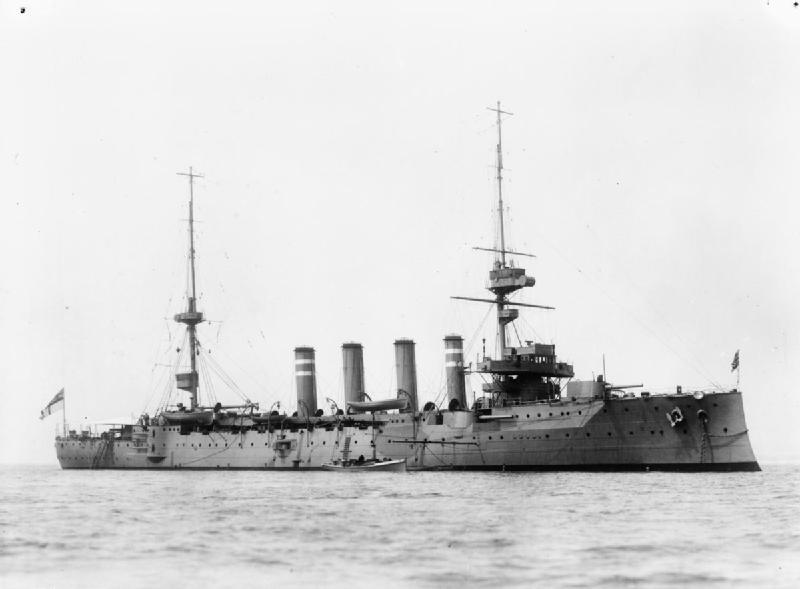Branch of service: Royal Navy, HMS Hampshire
Service No: 312109/PO
Date & place of birth: 27 March 1889 at Greatham, Hampshire
Date & place of death: 5 June 1916 (aged 27) off the Orkney Islands
Stoker/Petty Officer Herbert Arthur Gale had enlisted in the Royal Navy in 1907 and was killed in the sinking of HMS Hampshire off the Orkney Islands in which Field Marshall Earl Kitchener, the Minister of War was also drowned, leading to a large number of conspiracy theories.
Family background
Herbert Arthur Gale was born on 27 March 1889 at Home Farm Cottages, Main Road, Greatham, near Liss in Hampshire, the fourth child and second son of Henry Gale (1860–1923) and his wife Ellen née Tull (1861–1935). Henry had been born in nearby Steep and married Ellen, from Greatham, in 1878, following which the couple settled in the Liss/Greatham area where Henry worked as a cowman.
The couple’s first son, William, was born two years after their marriage, followed by two daughters, before Herbert was born in 1889. In 1901, the family were living at Ham Barn Farm, where both Henry and William were employed as stockmen. Rather than follow in his father’s footsteps, however, Herbert enlisted in the Royal Navy shortly after his eighteenth birthday.
In the spring of 1916, Herbert married Alice Matilda Pollard who was born in Heyshott in 1885. At the 1911 census, she was in service in Luton, Bedfordshire where she continued to work after the marriage.
Naval service
Herbert enlisted at Portsmouth on 22 August 1907, signing on for 12 years. On his enlistment papers, he is described as 5ft 3in, with brown hair and blue eyes and his disciplinary record is “Very Good”.
He spent the first few years of his navy service on board various training vessels in Portsmouth harbour, including HMS Nelson, HMS Hecla and HMS Victory before his first posting in January 1909, when he joined the Edgar-class cruiser, HMS Hawke as a stoker. In April, he transferred to the Drake-class armoured cruiser HMS King Alfred where he remained until May 1910. At the time of the 1911 census, he was serving on board HMS Flying Fish, a Star-class destroyer.
His next posting was on the Warrior-class armoured cruiser HMS Cochrane between August 1911 and April 1913, by when he had been promoted to Leading Stoker.

In January 1914, he was promoted to Stoker/Petty Officer on board the Devonshire-class armoured cruiser, HMS Hampshire, where he was to remain until his death. Prior to the war, Hampshire had been based on the China station and spent the early months of the war protecting Hong Kong before being ordered to take part in the search for the German light cruiser Emden which had been attacking British vessels in the Bay of Bengal. In December 1914, Hampshire escorted an Australian troop convoy through the Indian Ocean and Red Sea to Egypt.
In January 1915, Hampshire was assigned to the 7th Cruiser Squadron before going to the Barents Sea to escort shipping headed for Archangel. The following summer, she joined the 2nd Cruiser Squadron, as part of which she had a minor role in the Battle of Jutland at the end of May.
Death and commemoration
Immediately after the battle, Hampshire was ordered to carry Lord Kitchener from Scapa Flow on a diplomatic mission to Russia. Lord Kitchener was the Secretary of State for War; he had won fame in 1898 for winning the Battle of Omdurman and then played a significant role in the Boer War. His face featured in the iconic recruitment poster with the slogan “Your Country Needs YOU”.
At 4:40pm on Monday 5 June 1916, HMS Hampshire set sail from Scapa Flow accompanied by the destroyers HMS Unity and Victor. On leaving Scapa Flow, they ran into extremely heavy weather and within two hours the destroyers had been ordered to return to Scapa Flow, leaving Hampshire to sail on unprotected. Struggling against a Force 9 gale, she could only maintain 13.5 knots and was about 1½ miles offshore when she hit one of 22 mines that had been laid by a German U-boat a few days before. The ship was seriously damaged by the explosion and soon began to sink. Although attempts were made to launch lifeboats, these were wrecked by the severe weather and only 12 men were rescued, with 650 men, including Lord Kitchener and his entourage, being killed.
Herbert Gale’s body was never recovered and, as well as the Trotton war memorial, he is commemorated on the Portsmouth Naval Memorial on Southsea Common.
Conspiracy theories
The loss of Kitchener caused considerable grief in Britain but also inspired several theories that his death was the result of a conspiracy. Some claimed that the ship had been torpedoed by a submarine which was alerted to Kitchener’s presence on the ship by spies in the Orkneys. Others claimed that the ship was destroyed by a bomb planted by Irish Republicans. There were also suggestions that Kitchener was never on board Hampshire, but was replaced by a look-alike, with Kitchener being taken into hiding by the freemasons.
There are many websites discussing these theories including www.hmshampshire.co.uk .
Subsequent family history
Herbert’s widow, Alice re-married (to Thomas Penn) in Sussex in 1925 and she remained in the area until she died in May 1963. She appears to have had no children.
His parents were living at Empshott, near Greatham, in 1911. Their deaths in 1923 and 1935 were both registered at Midhurst, so it is assumed that they had moved into the area during the war.